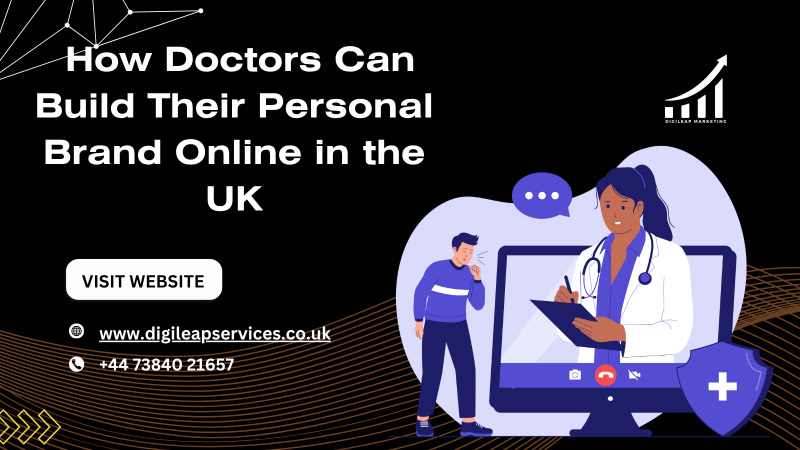Business
How Doctors Can Build Their Personal Brand Online in the UK

Have you seen those doctors who seem to be everywhere—tons of great feedback, a lively social media presence, and guest spots on podcasts? It’s odd when others, just as capable, don’t manage to stand out online. That’s the quiet power of a doctor's personal branding.
Let’s be honest—in today’s healthcare landscape, trust isn’t built just in clinics anymore. It’s built on screens. Patients Google symptoms and doctors before booking an appointment. According to a Statista survey
Over 75% of UK internet users rely on online sources for health information. So if your digital presence isn’t saying who you are and what you stand for, someone else’s will.
In this guide, we’ll walk through exactly how doctors' personal branding works, what’s trending in 2025, and how to use it smartly—without feeling like a “salesperson in a white coat.”
1. Why Doctors' Personal Branding Matters More Than Ever
Personal branding isn’t about showing off—it’s about showing up.
Patients today want authenticity. They want to know their doctor before they ever step into a clinic. Think of it like bedside manner—but online. When people see consistent posts, honest patient education, and real opinions, they connect.
A McKinsey report revealed that healthcare professionals with a visible online presence are perceived as 32% more trustworthy by patients. That’s huge.
And here’s the deal: you don’t need to be a social media influencer to achieve it. With a well-thought-out content strategy and support from digital experts like Digileap
Even busy doctors can build meaningful visibility without losing authenticity.
2. Defining Your Voice: The Foundation of a Doctor's Personal Branding
Before posting anything online, ask yourself:
What do I want to be known for?
Is it compassionate patient care? Expertise in dermatology? Modern surgical methods? This “why” will anchor your brand tone, content style, and even your visuals.
“Your brand is what people say about you when you’re not in the room.” – Jeff Bezos
For doctors, that room is now the internet. Essentially, a personal brand is making sure what people see about you online feels true to who you are. It’s reflected in things like your photo, a quick description of yourself, and also how you interact when others reach out—whether with comments or criticism.
Pro Tip:
- No matter how people connect—website visits, advertisements, or email—the overall impression should remain consistent. We aim for one clear feeling across all touchpoints, a seamless brand presence.
- Talk plainly.
- Be kind.
- Sounds sure.
The scent of disinfectant still clings to my memory, though I barely notice it now. It was different when I started—a sharp reminder of everything riding on steady hands and careful listening. A little girl named Lily, sketching rainbows while getting a shot, shifted something inside me. Before that, medicine felt like mastering puzzles; afterward, it became about those small moments where fear gives way to trust. So many faces pass through here, each story etched somewhere within. They remind me why this work matters, even on days steeped in exhaustion.
3. Building Trust Through Content: The Heart of a Doctor's Personal Branding
In 2025, content isn’t just king—it’s the clinic door. From short videos on preventive care to patient Q&A posts, every piece builds your brand story.
Let’s face it: today’s patients scroll more than they read brochures. Doctors really need to get online these days. Short videos on places such as Instagram or YouTube—even writing posts on LinkedIn—can help patients see them as both friendly and knowledgeable.
Working alongside Digileap makes things easier; they build healthcare plans centered on teaching people while also getting you noticed. From sharpening your Google presence to running a YouTube channel, it centers around sharing good stories regularly.
4. Leverage Modern Platforms to Amplify Doctors' Personal Branding
If you think social media is “not for serious professionals,” think again. The fastest-growing audience for healthcare content in the UK right now? Adults aged 35–54 — exactly your patient base.
Here’s what’s trending:
- Short-form video: A 30-second clip explaining a medical myth can reach thousands.
- Educational Threads on X (formerly Twitter): Bite-sized medical wisdom gets retweeted fast.
- Start a podcast—talk about health stuff to become known as someone who really knows their field.
- Creating a brand feels simpler these days. Tools such as Canva, alongside options like Magic Write—even using something like ChatGPT to brainstorm ideas—help maintain a unified look.
- Using these tools within your healthcare social media plan doesn’t just free up hours; it guarantees each update reinforces what your brand stands for.
5. Managing Your Doctor's Personal Branding Reputation
Your online presence doesn’t end when you log off. Reviews, mentions, and news stories all shape perception. That’s why online reputation for doctors is just as critical as your medical record.
One critical comment doesn’t sting so much when met with a caring reply, especially alongside lots of good stories from others. Get those satisfied folks talking about how great things were! Being upfront—responding to concerns openly and respectfully—creates far greater faith than silence ever could.
Quick Example:
Each week, London doctor Emily Khan spotlights a positive outcome from her practice on Instagram. Consequently, her follower count exploded—a jump of 340% over half a year. She didn’t push hard for attention; instead, she showed people the caring side of medicine.
If that’s not branding done right, what is?
6. Connecting Your Brand to Community and Cause
Another rising trend? Purpose-driven branding. Patients connect deeply with doctors who champion causes — from mental health awareness to sustainable healthcare practices.
This is where healthcare marketing in UK campaigns is evolving—beyond ads, toward advocacy. Doctors who collaborate with community drives or post educational reels on NHS topics often see stronger local engagement and press mentions.
Adding a “cause” to your personal brand doesn’t mean being political—it means being personal with purpose.
7. Analytics: Measuring Success in a Doctor's Personal Branding
Just like diagnostics, data matters. You can’t manage what you don’t measure.
Track your:
- track the Website traffic (via Google Analytics)
- Social media engagement
- Patient inquiries coming from online channels
- Soon you’ll notice trends—subjects that get people talking, content that comes across like a pitch, and also things audiences genuinely connect with.
- Consider what people say to refine how you present yourself - it shifts gradually.
- Building a doctor’s brand hinges on earning confidence - it isn’t self-promotion.
TL;DR
- A doctor's personal branding is about trust, not vanity.
- Patients research doctors online before booking.
- Authentic content and digital storytelling build credibility.
- Tools like digital marketing for doctors and social media strategy for healthcare make branding easier.
- Partnering with experts like Digileap can streamline your online growth.
- Track analytics and keep refining your brand voice.
Conclusion
In a digital-first healthcare world, your reputation begins before your consultation. These days, a doctor needs a distinct presence; it’s no longer something they can skip if they want to build strong patient relationships alongside practice growth.
How you present yourself online—whether via videos that truly connect, helpful articles, or simply explaining things clearly—directly impacts what happens in the real world. And if you need a reliable partner to help you craft that voice, Digileap UK offers tailored digital solutions that fit the pace and professionalism of modern medicine.
Because at the end of the day, branding isn’t about becoming famous—it’s about becoming found.
Source:
Click for the: Full Story
You might like













 Close Menu
Close Menu